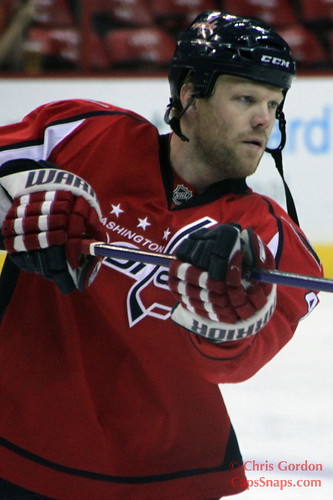During the thirty days of September, I'll be trying to preview the seasons of thirty players currently under contract with the Washington Capitals and who have a good chance of spending some time in red, white, and blue this season. Advanced stats are given from behindthenet.ca ranked against other players at the same position--forward, defense, or goalie--in the same organization, at 5-on-5, unless otherwise noted. Age is on opening night. Today, John Erskine)
John Erskine age 30, 6'4", 216 pounds, shoots left.
Contract: $1.5 million, UFA in 2011 per Capgeek.
2009-2010 linemates: 32% Brian Pothier, 23% Tom Poti, 14% Karl Alzner
2009-2010 raw stats:
NHL: 50 GP, 1-5-6, +16, 50 shots, 66 PIM
2009-2010 advanced stats: 8th in Corsi QoC, 6th in Corsi Rel QoC, 7th in Corsi QoT, and 8th (second-to-last) in Corsi Rel QoT. Zonestart 48.6% offensive zone (6th) with Zonefinish 49.8% offensive zone (5th).
(Photo courtesy Caps Snaps)
WOWY (yellow is how much better the player is with Erskine, green how much better Erskine is with the player):
John Erskine really is a question mark heading into the 2010-2011 season in more ways than just one. He is clearly one of the weaker links on a defense corps that at the moment boasts three NHL-caliber top-4 defensemen, two young defensemen who are expected to be top-4 level by season's end, a warm body used in case on injury on either forward or defense, and Erskine, a gritty but slightly injury-prone defensemen who doesn't spectacularly embarrass himself but is not particularly good, either, or at least we think. Erskine seems to have had pockets of good play with certain players. The question, then, is whether that is simply some luck over the season or a sustainable trend.
Erskine, as we can see above and as I mentioned in the Nicklas Backstrom preview, has much better numbers with Backstrom. That is to be expected--no player should see a dip in their proportion of shots when they play with the NHL's most dangerous offensive line--but the funny thing is, Backstrom's numbers are much, much better with Erskine as well. Is this a bias in the sample? Maybe. Perhaps all Erskine-Backstrom Corsi events were against the weak competition Erskine generally faced. Still, though, it's an interesting trend. Other players who looked better with Erskine include Alex Ovechkin, Mike Knuble, and John Carlson (looking at this, I'd make the pairings on opening night Green-Schultz, Poti-Alzner, and Erskine-Carlson, which gives two good offensive pairs and a shutdown pair, plus splitting up the inexperienced sophomores). Maybe Erskine's season averages are brought down because of the significant ice time he got with Brian Pothier and especially Tomas Fleischmann. I'll look into it as I go along writing these previews.
At any rate, Erskine did not only have curious trends in his Corsi%. His goals-against per sixty minutes of 5-on-5 ice time was second on the team to Jeff Schultz, with middling to below average teammates and competition. This gave Erskine a better plus-minus per sixty minutes of ice time at 5-on-5 than John Carlson, even with worse teammates and better competition. His GAON/60 wasn't much higher in 2008-2009, but Erskine had lower GFON/60 numbers despite a better Corsi QoT relative to other Caps blueliners. His good play at even strength could not carry over to penalty killing, though.
The question with Erskine becomes this: is he good enough of a 6th defenseman for a team to win a championship with? As we've seen since the lockout, successful teams in the playoffs frequently "shorten" their benches to four or five defensemen and give those defensemen, and only them, big minutes in all situations, especially the top-4. Erskine, who looks like the #6, won't have to play pressure penalty kills or last-minute-down-by-one power plays; he'll just have to come in, not give up too many goals over his even strength minutes, and head out. It seems simple enough--all Erskine has to do is maintain a semblance of the defensive play he has brought to the ice the last two or three years--but with Bruce Boudreau's occasional stubbornness to match lines and defense pairings, I'm still apprehensive. What happens if, on the road, another team catches the Caps with Erskine's pairing and Fleischmann's line on the ice?
I expect most of Erskine's statistics to remain mostly the same--a shot a game, one or two PIMs per game, a point every ten games, a quarter or more of the season missed due to both injury and healthy scratches, but most prominently, I expect a very low, if not zero, playoff-games-played total. It's clear that the Capitals did not trust Erskine to play in the playoffs, and I expect that lack of confidence to continue. On the one hand, he was alright against Philadelphia in 2008 in sheltered minutes. On the other hand, that will have been three years ago by the time April 2011 rolls around. One thing is for sure: Erskine will get his chance to prove that he is good enough to play in the playoffs before April rolls around.
Friday, September 10, 2010
Subscribe to:
Post Comments (Atom)




No comments:
Post a Comment